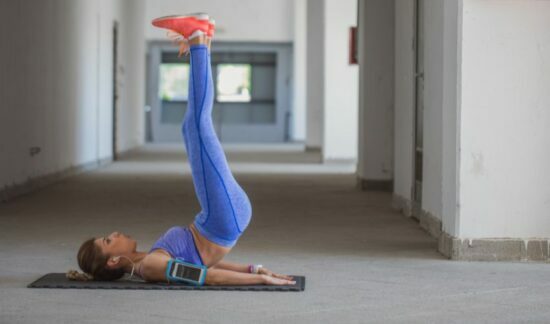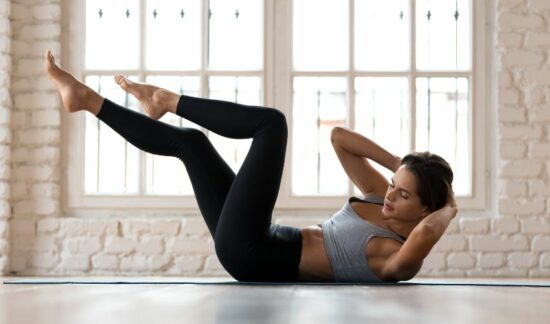Even if you go to the gym frequently and try to maintain a healthy diet, you may find that your lower abdominal muscles are not as toned and strengthened as they could be. This is a common problem that many individuals face.
You may improve the strength of your lower abdominals by performing exercises that focus on this region.
Strengthening your core muscles with exercises like planks, crunches, scissor kicks, and butterfly kicks will help you achieve your fitness goals and make it simpler to participate in other types of physical activity.
A study that was conducted in 2019 found that having a strong core can not only aid improve posture but also avoid injuries and alleviate back discomfort.

Need To Do Lower Ab Exercises
The lower abdominal muscles are an important group of muscles that play a key role in stabilizing the pelvis, supporting the lower back, and improving overall core strength. In addition to their functional importance, strengthening the lower abdominal muscles can also help to tone and shape the appearance of the abdomen.
Here are some of the main reasons why you might want to incorporate lower ab exercises into your fitness routine:
- The lower abdominal muscles are an essential part of the core muscles, which provide support and stability for the spine, pelvis, and hips. By strengthening these muscles, you can improve your overall core strength and stability, which can help to reduce the risk of injury during physical activity.
- Strong lower abdominal muscles can help to improve your posture by keeping your pelvis in a neutral position and supporting your lower back. This can help to reduce the risk of lower back pain and improve your overall alignment and balance.
- By strengthening the lower abdominal muscles, you can improve your overall strength and stability, which can help to reduce the risk of injury during physical activity.
- By toning and shaping the lower abdominal muscles, you can create a more defined and sculpted appearance in the abdominal area.
- Strengthening the lower abdominal muscles can help to improve your overall athletic performance by improving your core strength and stability. This can be particularly important for activities that require quick and explosive movements, such as running, jumping, and sprinting.
Overall, incorporating lower ab exercises into your fitness routine can help to improve your overall strength, stability, and appearance, while also reducing the risk of injury and improving your athletic performance.
Tips For Doing Lower Abs Exercises
Here are some tips to help you get the most out of your lower ab exercises:
- To effectively target the lower abdominal muscles, it’s important to engage your core throughout the exercise. This means pulling your belly button in towards your spine and keeping your core muscles activated throughout the movement.
- It’s important to maintain proper form throughout the exercise to ensure that you are targeting the correct muscles and minimizing the risk of injury. Make sure to keep your back flat on the ground, your neck relaxed, and your shoulders down and away from your ears.
- Proper breathing is essential for effective lower ab exercises. Inhale deeply as you prepare for the movement, and exhale as you engage your core and lift your legs or hips.
- If you’re new to lower ab exercises, start with simpler movements and gradually build up to more challenging exercises. This can help to ensure that you are performing the movements safely and effectively.
- Some lower ab exercises, such as leg lifts or hanging knee raises, may require the use of equipment like a stability ball or pull-up bar. Make sure to use proper equipment and set it up correctly to ensure your safety and maximize the effectiveness of the exercise.
- To keep your lower ab workouts challenging and engaging, it’s important to incorporate a variety of different exercises. This can help to target the lower abs from different angles and prevent boredom.
- Consistency is key when it comes to building strength and toning the lower abdominal muscles. Aim to perform lower ab exercises at least 2-3 times per week to see results over time.
By following these tips, you can effectively target and strengthen your lower abs, improve your core strength and stability, and achieve a more toned and defined abdominal area.
10 Exercises That Will Assist Decrease Your Abdominals.
The following are some workouts that you can include in your normal practice of working out.
If you are able to do so, you should give a workout for your lower abs a few times a week at the very least. Allow yourself a day of recuperation in between each session of your training. As you get better, you should feel free to increase the number of repetitions and sets you do.
Before beginning any new workout regimen, you should first consult your primary care physician if you suffer from any chronic diseases.
When you are executing the exercises, you should focus on engaging the lower part of your abdominals and pushing yourself without going too far.
Perform these workouts in a risk-free manner by utilizing motions that are fluid and well-controlled. Always make sure you use the correct form.
You should consider doing some little stretching in the intervals between the workouts.
1. Ab Contractions.
How to Do:
- Place yourself on your back with your knees bent and your feet planted firmly on the ground.
- Put some pressure on your lower back into the ground, and then make a very small movement to bring your navel into your spine, which will tighten your core.
- Maintain this contraction of your abdominal muscles for the next thirty seconds, and then release it.
- After a short break, repeat the process anywhere from one to three times.
During the workout, it is important to remember to take calm, deep breaths. If you feel that thirty seconds is too long, begin with ten to fifteen and gradually increase your time.
2. Leg Drops.
How to Do:
- Position yourself so that you are laying on your back with your legs raised in the air and your arms next to your torso.
- Lower your legs to the floor in a controlled manner, then quickly raise them back up again just before they make contact with the floor.
- Make sure that you keep your lower back pressed into the floor at all times.
- Perform one to three sets of 10 to 16 reps each.
Advice: If you feel your lower back starting to rise off the floor while you are doing this exercise, stop where you are and raise your legs until they are in the starting position. To provide yourself with more support, try forming your hands into a triangle and positioning it beneath your hip bones.
You can add variety to this exercise by performing leg half-drops, in which you lower your legs to a 45-degree angle and then raise them back up, or by performing single-leg drops (lower one leg, bring it back up, and then switch legs).
3. Hip Raise.

How to Do:
- Position yourself so that you are lying on your back with your arms extended along the sides of your body.
- Raise your legs so that they are parallel to the floor.
- Put some pressure on your feet so that they point up toward the ceiling. This will help you lift your hips off the ground.
- Repeat the last step while lowering your hips to the floor.
- Perform one to three sets of 10 to 15 reps each.
Tip: Maintain control as you descend your hips toward the ground. Every time you raise, let out an exhale.
4. Boat Posture.
How to Do:
- Take a seat on the floor with your legs out in front of you and your knees bent.
- The “V” form will be created when you roll back onto your sitting bones and extend your legs to a 45-degree angle.
- Extend your arms out to the side so that they are parallel to the floor with your palms facing upward.
- Maintain this position for at least 60 seconds and up to a minute.
- Take a break, then repeat steps one to two.
A helpful hint is to pull your lower belly button into your spine. Lift your chest. To add variety, try merely raising your feet such that they are level with your knees.
5. Mountain Climbers
How to Do:
- Assume a high plank stance with your hands positioned underneath your shoulders.
- Make a 90-degree bend in your right knee and put your right shin in front of your chest.
- Bring your right knee to the starting position, then step forward with your left foot while keeping your right leg bent.
- Carry on moving in this manner for up to one minute.
- Take a break, then repeat steps one to two.
Important: This is not a race! Move slowly and deliberately through these motions. By engaging your core, you can ensure that your hips and shoulders remain in a level position.
6. Rocking Plank.

How to Do:
- Assume a low plank position on your forearms with your elbows positioned just beneath your shoulders.
- Move forward and backward while shifting your body.
- Keep moving in this manner for the next minute.
- Take a break, then repeat steps one to two.
Advice: Make sure that your neck, spine, and hips are all in one straight line. Your lower abdominal muscles should be your primary focus.
7. Scissors Kicks
How to Do:
- Position yourself so that you are lying on your back with your arms next to your body and your legs elevated up to a 90-degree angle.
- While maintaining your left leg up, slowly lower your right leg down to the ground.
- While you are raising your right leg back up, descend your left leg in a slow and controlled manner.
- Maintain the pattern of lowering and rising your legs in alternate motions.
- Perform one to three sets of 10 to 16 reps each.
Avoid bending your knees quite as far down if you notice that your lower back is starting to arch (aim for 45 degrees). Try some open scissor kicks for a bit of variety (extend your legs straight up toward the ceiling, slowly lower your right leg, bring it back up, and then alternate to your left leg).
8. The Hundred.
How to Do:
- Position yourself so that you are lying on your back with your legs drawn toward your chest.
- Bring your head, neck, and shoulders closer together.
- Keep your arms hovering along the sides of your body.
- Extend both of your legs out to the side until they are at a 45-degree angle.
- Do five repetitions of pumping your arms up and down, first while inhaling for five pumps and then while exhaling for five pumps.
- Perform ten sets of ten repetitions of breathing exercises (100 pumps).
Advice: Take a breath in through your nose, and then exhale through your mouth. Alternately, you can bend your knees to a right angle of 90 degrees and draw them in toward your chest.
9. Bicycle Crunches.

How to Do:
- Position yourself so that you are lying on your back with your fingers interlaced to support the base of your skull.
- Bend your knees in 90 degrees.
- Hold this position while you rotate your right shoulder and elbow toward your left knee. Extend your right leg out in a straight line.
- As you bring your right leg back to a 90-degree angle, extend out your left leg and rotate your left shoulder and right elbow toward your right knee. Continue to bring your right leg back to a 90-degree angle.
- Keep moving in this manner, switching sides every so often.
- Perform one to three sets of 12 to 18 reps each.
A helpful tip to maintain a strong core is to tuck your navel down toward your spine. Holding both knees at an angle of 90 degrees for a few seconds can serve as a quick break if you need one.
10. Flutter Kicks.
How to Do:
- Position yourself so that you are lying on your back with your arms next to your body.
- Raise your legs so that the soles of your feet are approximately 15 centimeters above the ground.
- Reduce the height of your right leg by a few inches as you simultaneously raise the height of your left leg by the same amount.
- Reverse your direction of travel by slowly raising your right leg a few inches while simultaneously lowering your left leg a few inches.
- Carry on moving in this manner for up to one minute.
- Take a break, then repeat steps one to two.
Advice: Make sure that your lower back is supported by the floor.
Lower Abdominal Workout Precautions And Safety Issues
When engaging in any kind of exercise routine, there are always many precautions you should take into consideration. Exercises that target the lower abs are similar. You should give some thought to the following precautions before beginning a workout that targets your lower abdomen region:
- If you are currently managing any kind of health problem, you should consult with your physician before beginning a new exercise routine.
- It is important to be warmed up before beginning an exercise.
- Concentrate on the form.
- Perform only as many repetitions as you are capable of while still preserving good form.
- If it hurts, you need to stop.
The Bottom Line.
By performing these exercises on a continuous basis, you should be able to notice gains in both the strength of your lower abs as well as their look. You should incorporate both aerobic activity and weight training into your workout routine.
Eating a diet that is well-balanced and rich in nutrients can also go a long way toward developing a strong and toned core.
Make sure to get plenty of rest, drink lots of water, and make an effort to engage in some form of physical activity on a daily basis, even if it’s just for a few minutes.
Have a conversation with your primary care physician before beginning any new workout routine. This is of the utmost significance if you are currently managing any medical issues or are taking any drugs.